Tackling the Hell of the East (Coast)
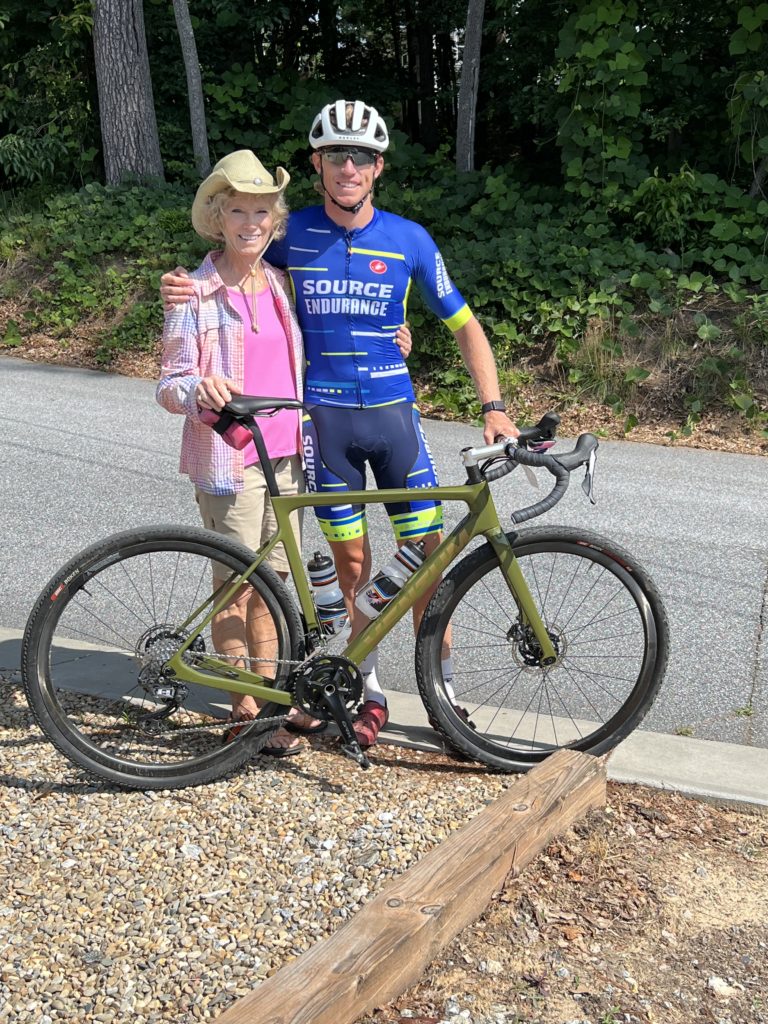
Just six short weeks after the first Belgian Waffle Ride in San Diego, the second stop of the Quadrupel Crown of Gravel took place. This time the traveling gravel circus took roots in the East Coast, somewhere about 30 miles south of Asheville, North Carolina along the border of South Carolina. BWR North Carolina was all that I expected plus a little bit more. I stuck to a similar race strategy, nutrition strategy and my equipment choice was almost identical, with just a tad bit of difference. Before getting into the nitty, gritty details, let’s examine the differences in geographical location. When you ride a road bike, asphalt is just about the same everywhere you go, with subtle differences. When you ride gravel, depending on where you are in the country, the texture and type of gravel can vary quite a bit. San Diego and the surrounding area is pretty rough, loose over hard, clay, wash boarded, rutted and extremely dry. In the Blue Ridge Mountains, the gravel is typically a lot smoother, very clean, with crushed white rock, similar to what you might see in a World Tour race like Strade Bianche. Knowing your terrain is vital to getting a leg up on the competition. I made a couple assumptions that I ended up paying for due to my lack of course knowledge, and this is what makes gravel events and racing truly epic.
When it comes down to raw numbers, the BWR North Carolina was extremely similar to the California edition. It was 130 miles long, with some 13,000ft of climbing, which both metrics were not too dissimilar to what I found in San Diego. Temperature on race day was very pleasant, a cool 60 degrees at the start with a high of only about 75 degrees. This made hydration much less complicated, something I was extremely grateful for. My fueling for San Diego was pretty on point, so I tried to emulate the same strategy.
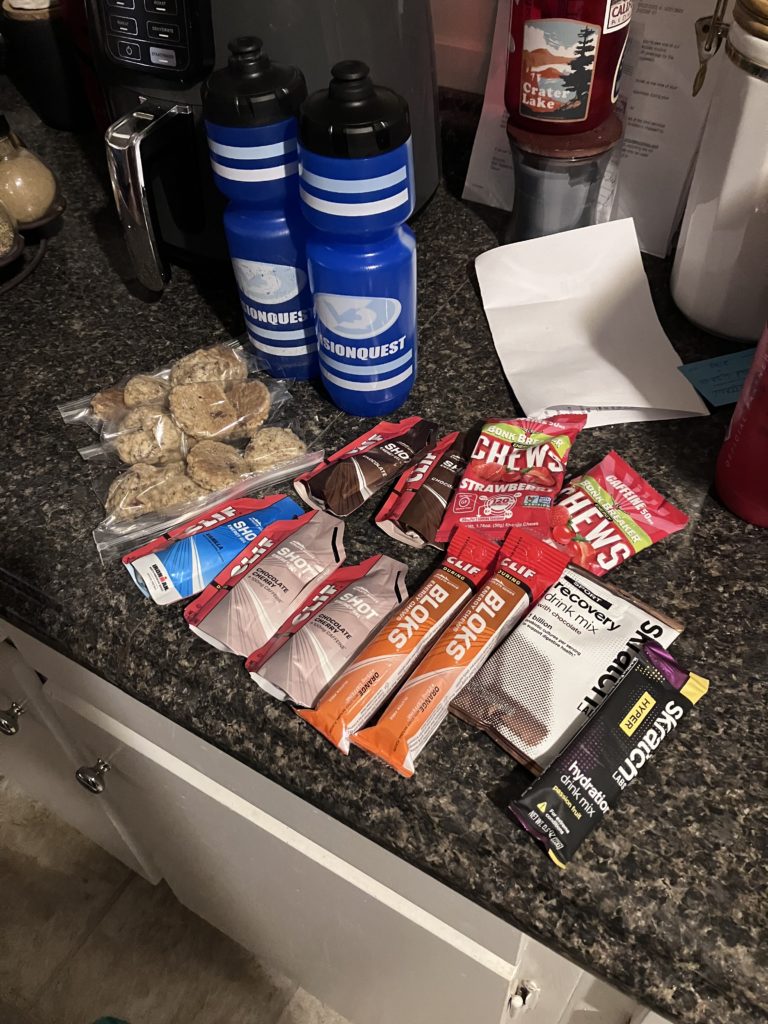
This was the fuel I brought with me on the ride. I took a Skratch Hyper Hydration before the race, essentially starting the ride with a third bottle already in my stomach! In the bottles, I had 1.5 sachets of SIS Beta Fuel, 120g of carbs in each bottle. I had 5 gels in my pocket, two that included caffeine. Also included were Clif Shot Bloks as well as Bonk Breaker Chews. Last but not least, I took 12 tiny homemade cookies with me as well. If my estimations of grams of carbs per cookie are correct, the total amounted to around 715g of carbohydrates, or somewhere in the ballpark of 100g of carbs per hour. Had everything gone to plan, I was set. If I needed more, the event had fantastic Aid Stations to supplement my needs if I had issues. I had two big issues, at one point I wanted a caffeine gel and I ended up dropping two other gels in my pursuit for the caffeine one. The second mistake was thinking I could eat dry cookies on the bike while racing, I think I ended up eating 1 or 2. However, I was able to grab bottles of mix in the feed zones as well as a Hammer gel flask, so in the end I probably wasn’t too far off my original nutrition intentions.
Again, I raced my Ventum GS1 gravel machine. It rides extremely similar to my road machine, so I feel at home. With a little slacker geometry and a longer wheelbase, it rides on the dirt like a mountain bike but it has the stiffness and responsiveness of my road bike and never feels slow when I’m drilling it on the road. Same gearing as San Diego, with a compact chainring setup of 46/30 and a 11/34 cassette in the back. The low end is quite low, which was perfect for the endless climbing. My wheel choice, as well as my tire choice was different from the Cali edition. I went with a lighter setup, 3T wheels that weigh in at about 1300 grams and I ran IRC tires with a Double Cross 40mm in the front and a Boken 40mm in the rear. This setup is the best of both worlds and I would highly recommend it for technically challenging gravel races. The aggressive front tire adds a little bit and grip for the loose descents and the file tread rear allows for a little bit of controlled sliding with a low rolling resistance for the many miles of road riding.
So, I’ve covered my gear setup as well as my fueling strategy. Mostly the same, but different to San Diego, but what about the race???? I always like to reflect and break down races in two distinct ways. First, I’d like to tell the story from my perspective, the subjective side of things. Next, along with WKO5, I’ll tell the objective story or what I gleaned from what my power meter, head unit and heart rate monitor was telling me.
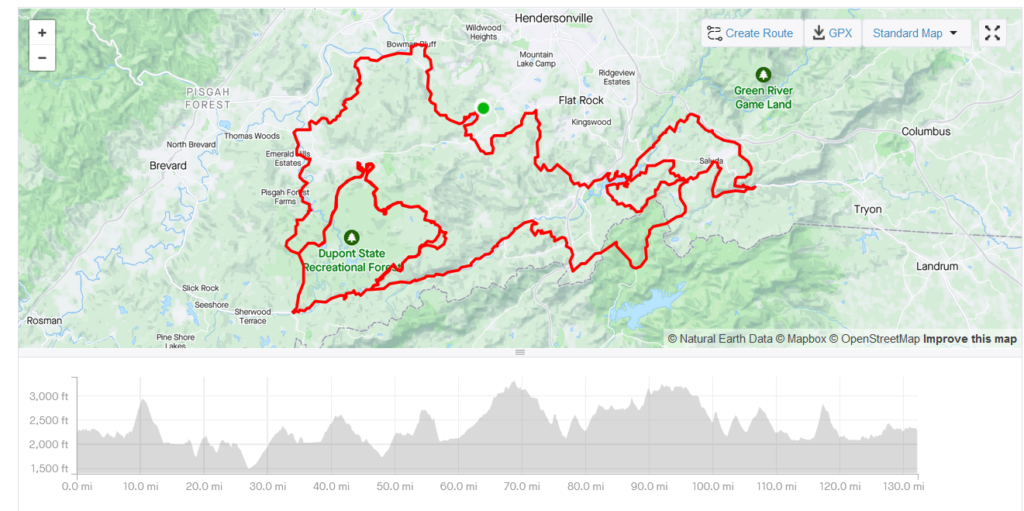
Ok, this is my story. Everyone has their own unique perspective of how the race played out, what went well, what went wrong and how to learn to improve for the next one.
The race kicked off at 7am, much too early in my opinion. I forced my way to the beginning of the starting grid, as position in the first 7 miles was of vital importance. As we rolled out of the Kanuga resort, the tension was palpable. I made sure to ride in the top 10 wheels until the selections were made. 7 miles in was the first test and I was positioned very well, first wheel in fact. We climbed Lake Falls, a gravel segment that was about 2 miles in length with an average gradient of around 7%. I sat first wheel for probably the first 4 minutes of the climb and set a hard pace that I knew I could hold but was going to discourage riders from pushing the pace harder. Eventually I fell back on wheels and felt as if I was at my limit right towards the top of the climb. I went over the top of the climb probably 10 seconds off the lead 20 riders, a gap I was confident I would easily cover on the descent.
I ripped the descent and was in the front group. Things were pretty relaxed at this point and that allowed a fairly large group to come back to the front. Going into the next set of challenges, the lead group was likely 40-50 strong. Next, we hit some twisty flat gravel roads along Lake Summit before tackling the next series of climbs. After 40 miles, the group was again reduced to around 20 riders or so and I was climbing well so I was able to hang in without too much difficulty.
Coming into mile 53 was the first major challenge of the ride and my first big mistake. I didn’t know the sector coming up and was not clued into the physical or the technical difficulty of it. I came into this sector positioned not particularly well, close to the last wheel in the lead group and I paid for this heavily. We came into this incredibly steep sector, with big fist sized rocks. Traction was quite low and several riders in front of me had to come to a stop and dismount. In turn, this forced me to dismount. I found myself running a portion to get to a spot that was flat enough to remount. I yelled “cross is coming” and did a super awkward running remount, to which I landed super nose heavy on the saddle and heard a loud crack, which was my carbon saddle clamp breaking loose and tilting my saddle negative 15 degrees. I rode in this position for the rest of the race. RIP to my triceps and back.
After battling some very dark thoughts, I regathered myself and committed to the chase. I was descending very well on the day, so I was able to regain contact with a small group of four riders that had also been dislodged on the technical single trail. We rotated and worked well together on the road section that followed and came into the next dirt section together. This next section was a long rocky climb, followed by a fast chucky descent. The riders in the group I was in were pushing me to my limit, so I decided to back off on the climb and gamble that I could ride the descent well enough to latch back on. An hour later, and my assumption was correct, as I came back to three of the four riders I was with and trailing close behind another group of four maybe 1 minute in front.
My legs were feeling quite good still and I kept pushing a hard pace that felt sustainable, as we were still only 80 miles in with 50 hard miles to go. At this point, two of us pushed on and started lap 2 of 2. Eventually I pushed on alone in pursuit of the group of four in front of us. After ripping the long descent off Pinnacle Mountain for the second time, I made contact with the group I was chasing. I worked and rode with these riders for the next 30 or so miles, probably doing more work than I should have and I paid the price when we hit the last climb of the day.
At mile 120 we hit Jeter Mountain, a very steep road ascent and I found myself losing contact with the group I was in. At this point, I was seven hours into the race, which was my predicted finishing time and I think the extra 30 minutes it took me to finish really did me in. I was pushing upper endurance pace, and that really felt like all I had left. I was caught by three other riders off the descent and when the attacks came towards the finish, I struggled to hang on. In the end, I rolled in solo in 15th place, 7 hours and 28 minutes after the starting gun went off. I was happy with my ride, but not satisfied. I’ll take the lessons I learned in my second gravel race into my next one with the goal of upward progression!
Yup, that’s my perspective of how the North Carolina BWR played out for me. Now, let’s see if the numbers agree and what kind of story they tell me.
Strava gives a good representation of the overall ride map. The race ended up being just shy of 130 miles, and my Wahoo head unit gave me a whooping 14,000ft of elevation gain on the day, being the most amount of climbing I have ever done in a single ride.
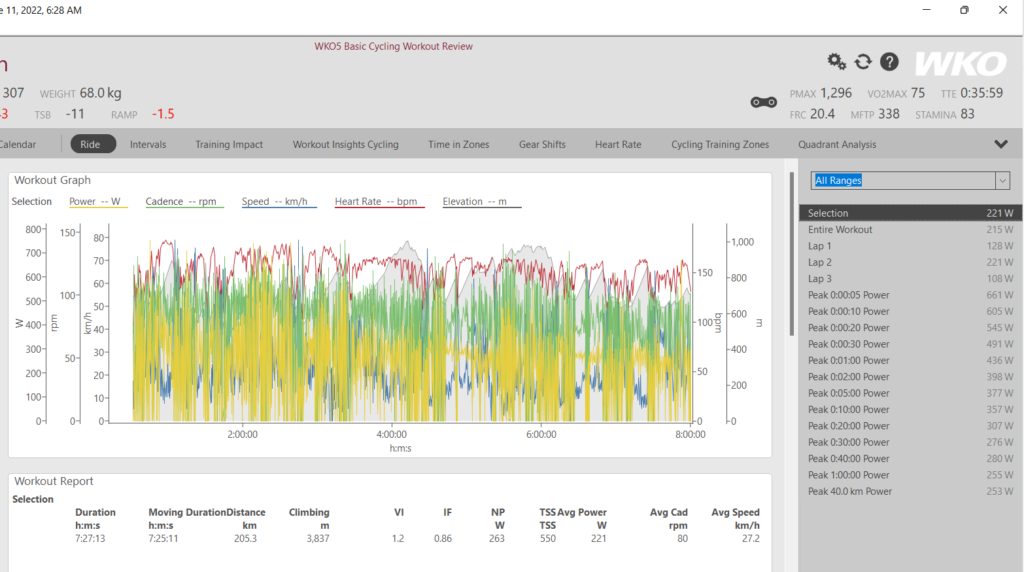
This time around, I’m using WKO5 to analyze the details of my ride file. I averaged 221 watts for 7:27:13 with a NP of 263 and a ridiculous 550 TSS! Looks like I don’t need to train for the rest of the week. This gave me an intensity factor of .86, so I was definitely at my limit for that time duration. The day of BWR, my threshold was estimated at 339 watts and I am weighing in at about 68 kilos these days.
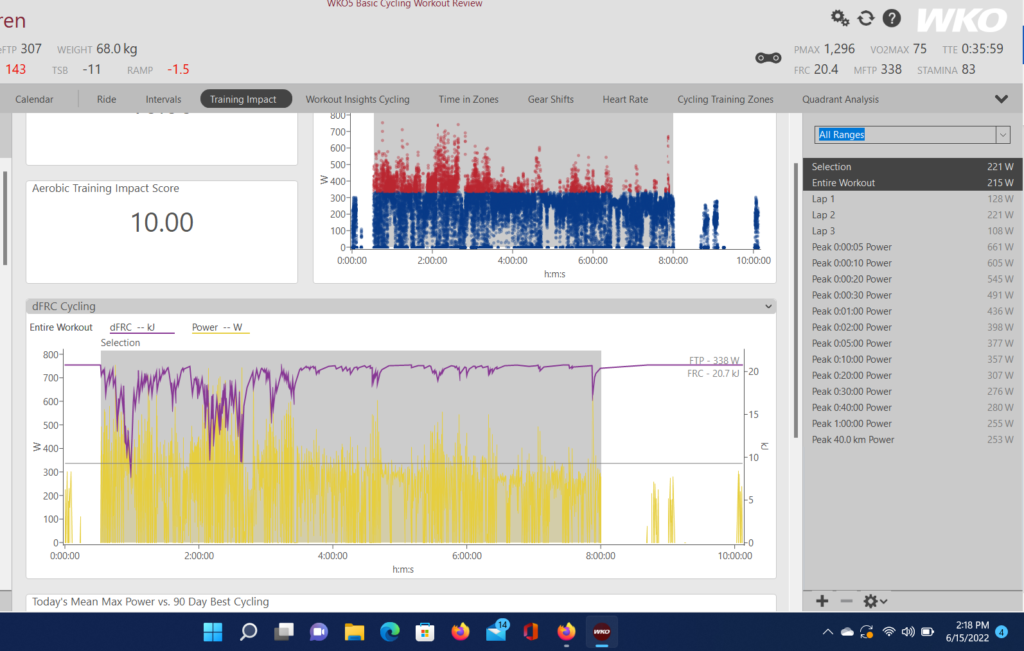
I like this graph, as it shows Dynamic Functional Reserve Capacity (dFRC) and power. I can look at this graph and get a good representation of every time I was at my limit. I was going over my threshold quite a lot in the first 2.5 hours and once I was out of the lead group, the efforts were much more manageable as I rode closer to tempo and sweet spot. I again used a front-loaded, positive split pacing strategy, as the longer you stay in the lead group, the longer you can take advantage of drafting and working with lots of other riders. The variability index of riding in the lead group is much higher, as you are either pushing close to or over threshold or coasting/not putting out much power at all.
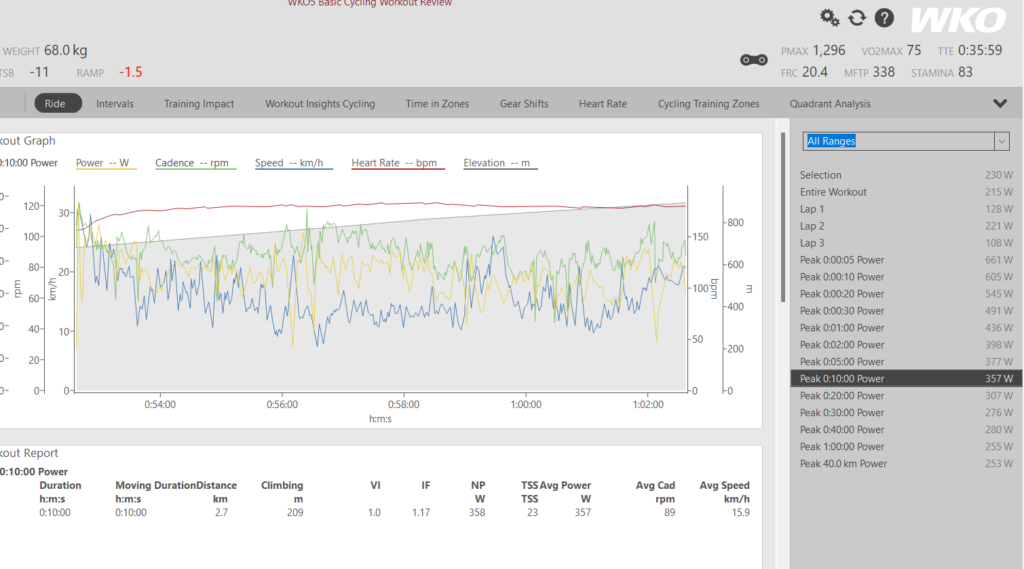
This image represents my best 10-minute power of 357. This was required to stay in the lead group over the first climb. Nothing too crazy, but also in the context it is pretty daunting as it is 20 watts over my threshold 20 minutes into a 7+ hour race. Alas, it is necessary to be competitive and stay with the leaders.
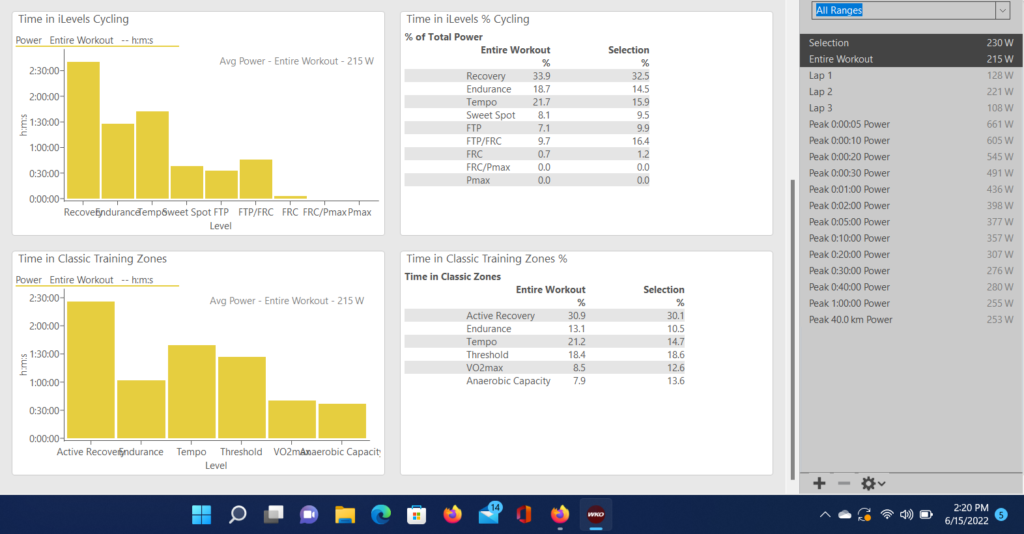
These two screen grabs represent zone distribution, heart rate and power respectively. The majority of time was spent at tempo heart rate, which makes sense. 151 bpm average is about my aerobic threshold, or just about as hard as I can go for 7 hours. There wasn’t too much aerobic decoupling, which shows I came in with great fitness and I stayed fairly hydrated.
For power distribution, I spent the majority of the time in zone 1!! This is likely to do with all the coasting when I was in groups or descending. Time at tempo and threshold were next if you use a classic training zone model. I spent an hour and 26 minutes of time at threshold, or 19% of the total time, which makes my legs hurt just looking at it.
All in all, stop two BWR North Carolina was highly successful. I produced more power for longer and this was reflected in my better placement. It gives me even more insight as to what it takes to be successful at these types of events. I came into this event with better endurance and a higher threshold, both necessarily for performance at BWR. Now, I set my vision to BWR Cedar City where I will put my lessons into practice and look for a top 10 at the next stop of the Quadrupel Crown Series!
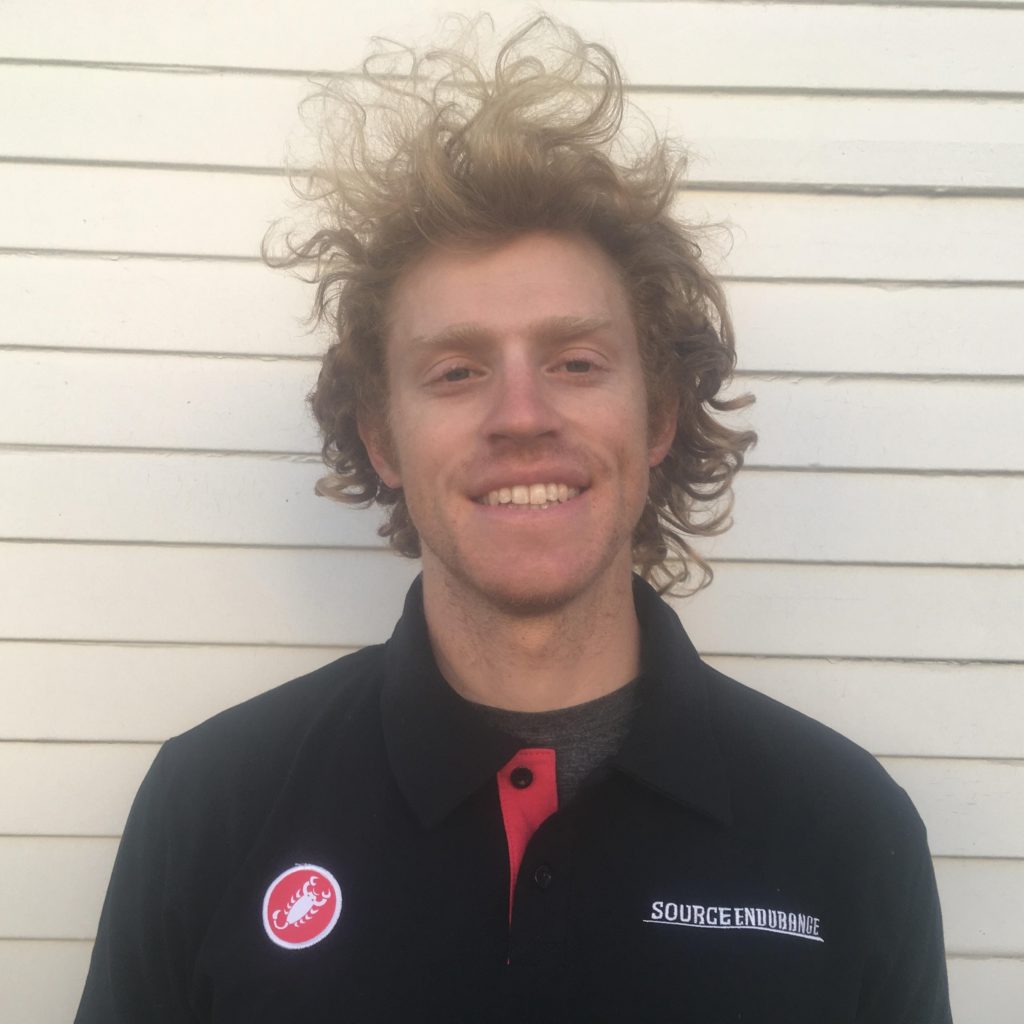
About the Author:
Taylor’s journey into the world of bikes started back in 2009 when he would join his dad once a week to cross train on the West Orange bike path in Orlando, Florida. After competing in the local time trial series, cycling quickly blossomed into a full-time passion and it was game over for all other sports: Taylor was a bike racer in the lifelong pursuit of speed, health and finding the never-ending limit of human performance.
In 2015, Taylor Warren, BSED earned his Bachelor’s Degree in Exercise Science with a focus in Sports Medicine at Colorado State University while competing in collegiate racing on the road and track, rising to the rank as Category-1 racer in both disciplines. As part of his education, he worked in labs performing physiological testing and assessments for athletes of all abilities. Taylor’s expertise in physiology transformed his passion for racing into learning how to apply the science in everyday training for the human body's optimal performance, and quickly led him to coaching others.
After graduating school, Taylor raced professionally on the road with the Colorado-based team, the 303 Project. Racing with the 303 Project provided invaluable experiences that Taylor brings to the table with the athletes he coaches. While training and racing full time, Taylor honed his coaching craft working one-on-one with athletes on the road, track, cyclocross racers and mountain bikers.
Today, Taylor calls San Diego home where he works in a bike shop performing bike fits, trains to meet the demands of the US Pro Road Tour calendar, and applies the latest sports science to the athletes he coaches including himself. At the core of his coaching, Taylor believes balancing life demands with the eustress of training, while keeping the process fun, is the key to progression and a lifelong passion for health and fitness.
